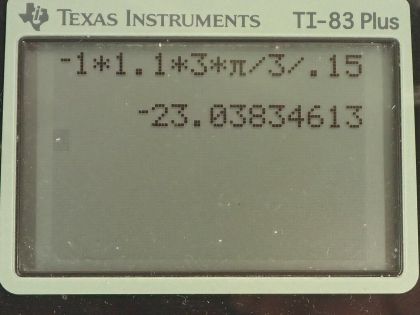Question
Assume that a baseball bat being swung at 3π rad/s by a batting machine is equivalent to a 1.1 m thin rod with a mass of 1.0 kg. How fast would a 0.15 kg baseball that squarely hits the very tip of the bat have to be going for the net angular momentum of the bat-ball system to be zero?
Final Answer
Solution video
OpenStax College Physics for AP® Courses, Chapter 10, Problem 20 (Test Prep for AP® Courses)

vote with a rating of
votes with an average rating of
.
Calculator Screenshots
Video Transcript
This is College Physics Answers with Shaun Dychko. A baseball bat is being swung such that it hits a ball on the very tip of the bat and the velocity of the ball is directed such that it's perpendicular to the length of the bat and the bat has a length of 1.1 meters and a mass of 1.0 kilogram and the ball has a mass of 0.15 kilograms and we are told that the bat is like a thin rod with an axis at the end and we want to find what speed does this ball need such that there's zero angular momentum in the system? So there will be a positive angular momentum the way I have drawn it here for the ball and a negative angular momentum for the bat and those have to add up to zero. Okay! So the angular momentum of the bat is its moment of inertia times its angular velocity— which we are told— and the angular momentum of the ball is the ball's moment of inertia times the ball's angular velocity so to speak I mean the ball is not really going in a circle over a long term here but we can imagine that at the instant it's contacting the bat, we can imagine the circle that it would be part of if it was to go in a circle and so it will have an angular velocity. So the moment of inertia for the bat we can look up in this table and for a thin rod with an axis about the end, its moment of inertia is its mass times its length squared over 3 so that's where this comes from and then the moment of inertia of the ball it's a point mass... this distance l from the axis of rotation and so it's going to be mass of the ball times distance from the axis of rotation squared, which is the length of the bat squared. So the angular velocity of the ball we imagine is its linear velocity that we are gonna try and find v divided by its distance from the axis of rotation, which is l so then we can plug in for each of these factors in the equation which says the total angular momentum is zero. And so we have the moment of inertia of the bat substituted here times the bat's angular velocity then the moment of inertia of the ball is substituted here times the ball's angular velocity and all this equals zero. We can divide by l squared by l to make l to the power of 1 subtract this term from both sides so minus m bat times l squared ω bat over 3 from both sides and then we have this line here and then divide both sides by mass of the ball times l and we have l to the power of 1 then times mass of the bat times the angular velocity of the bat divided by 3 times the mass of the ball and this is negative, which just indicates that the velocity of the ball is opposite to the velocity of the bat. So it's negative 1.0 kilogram—mass of the bat— times its length of 1.1 meters times its angular velocity of 3π radians per second divided by 3 times 0.15 kilograms— mass of the ball— that is negative 23 meters per second.
